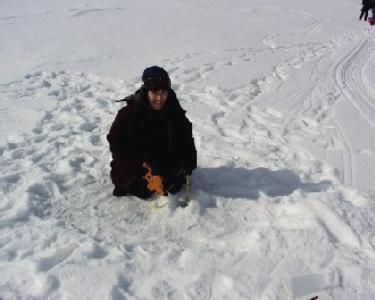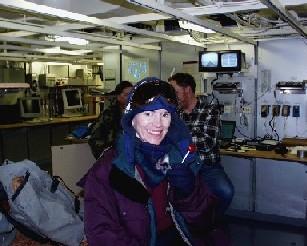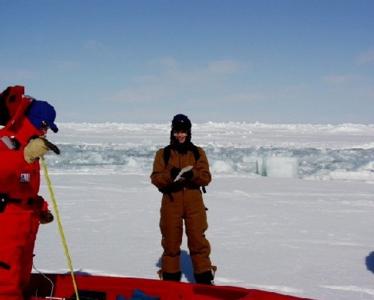
|
6 May, 2000Profiling Ice Thickness DRAFT May 6, 2000 Daily Data (20:30): Lat. 6828.0893N Long. 06308.7137W Heading 2.272 Air Temp. -7.74C 18.07F True Wind Dir. Calm True Wind Speed Calm USCGC Healy Facts: Shaft Horsepower: 30,000 Max HP Propellers: 2 Fixed Pitch, 4 Bladed Auxiliary Generator: EMD 16-645F7B 2400Kw Inuit Language Lesson from Stevie Audlakiak: Pegausot (ping nyah’ shoot): Three Tesamaut (tee’ saw mawt): Four Dear Everyone, I love being on the ice! It's a clear, sunny and calm day. Gorgeous. Peaceful. Severe and splendid beauty. After slathering SPF 50 sun block on my face, I headed off to the ice floe with the ice profile thickness teams. There were three groups of us with around fifteen people. This included one person on Coast Guard Bear Watch duty plus our two Healy Inuit guides, James Qillaq and Stevie Audlakiak. James and Stevie have the keenest eyes on board for spying wildlife. I observed them periodically scan the horizon this afternoon. Stevie tells me that Polar Bears hunt like foxes and can come anytime, anywhere. Yesterday was my first time on an ice floe. Even though it was a little cloudier and windier, I was thrilled to get off the Healy with the ice profile thickness teams. We were on the floe in the morning for work and back again for our Healy Arctic Cinco de Mayo celebration. Just as thrilling as it was being on the floe, was getting onto it! I went over the side of the Healy with the first group; John Gagnon, Mike Healy, Bill Hamburg, and Michael Faley of Coast Guard Bear Watch. A crane at the stern of the ship lifted us up and then over the Healy's side in a metal "basket" (weight limit of 800 lbs.) and then down onto the ice floe. Vocabulary of the day: >From MANICE; Manual of Standard Procedures for Observing and Reporting Ice Conditions, Canadian Ice Service, April 1994. First -year Ice: Sea ice of not more than one winter's growth, developing from young ice; 30 cm. or greater. It may be subdivided into thin first-year ice/white ice, medium first-year ice and thick first-year ice. Thin First-year Ice/White Ice-First Stage: 30-50 cm. thick Thin First-year Ice/White Ice-Second Stage: 50-70 cm. thick Medium First-year Ice: 70-120 cm. thick Thick First-year Ice: Greater than 120 cm. thick Vocabulary from John Gagnon, Cold Regions Research and Engineering Laboratory (CRREL), Hanover, NH: Free Board: The thickness of the ice above the water. Profiling the characteristics of the ice addresses the thickness of the ice, strength of the ice, and the thickness of the snow. Yesterday we focused on collecting data on the thickness of Thick First-year Ice. There are two parts to this process. In the first procedure, a hole is drilled and ice thickness measured. Measurement data recorded includes snow depth, ice thickness and free board. We repeat this cycle every 100 meters for the length of the broken ice of the ship test. For example, yesterday this was done for 1,400 meters and this afternoon we measured a distance of 900 meters. James Qillaq leads the way trailing behind him a 100-meter measuring tape and marks the snow for the location for drilling each hole. The second stage of the thickness measurements on the ice floe employs an electromagnetic device (EM31) to measure the snow and ice thickness. This is done by measuring the conductivity between the seawater and the ice. By placing this data into an equation, the reading is converted to ice thickness. An electromagnetic reading is completed every five meters for the length of the ship test. While this measurement is being documented, the team measures and records the depth of the surface snow. The devise used for this measurement is simply a ski pole with a measuring tape on the side. Upon returning to the Healy's science lab, the snow depth measurement is subtracted from the total snow and ice measurement to yield the thickness of the ice. The thickness of the snow has a significant impact on the ship's operational characteristics because of the friction that occurs between the ship's hull and the snow and ice surface. The Healy has a special system on board for minimizing this friction. It is called the "Deluge System" (bow wash system). The Deluge System pumps 360,000 gpm (gallons per minute) of seawater onto the snow covered surface of the ice to decrease the snow's friction on the hull of the ship when it is icebreaking. Why are we collecting this data? The thickness and strength of the ice is needed to define the operational characteristics of the icebreaker Healy. Can the Healy break 4 ˝ feet of ice that has a strength of 100 psi (pounds per square inch) at a speed of 3 knots? The ice trials of the Healy address this question. After we took our turns being hoisted by crane to the Healy's main deck and traipsed into the science lab area, Terry Tucker, Co-Chief Scientist, handed each of us a Tootsie Pop. Tired from the hours of walking in difficult snow while laden with heavy boots and clothing, Terry was doing what every good leader does. It was this acknowledgement that put smiles on our faces. We informally debriefed while Tootsie Pops decreasingly puffed out our cheeks. Best regards, Sandra For photos and more: ../tea_kolbfrontpage.html For further information: ../ http://www.uscg.mil./pacarea/healy
Contact the TEA in the field at . If you cannot connect through your browser, copy the TEA's e-mail address in the "To:" line of your favorite e-mail package. |













